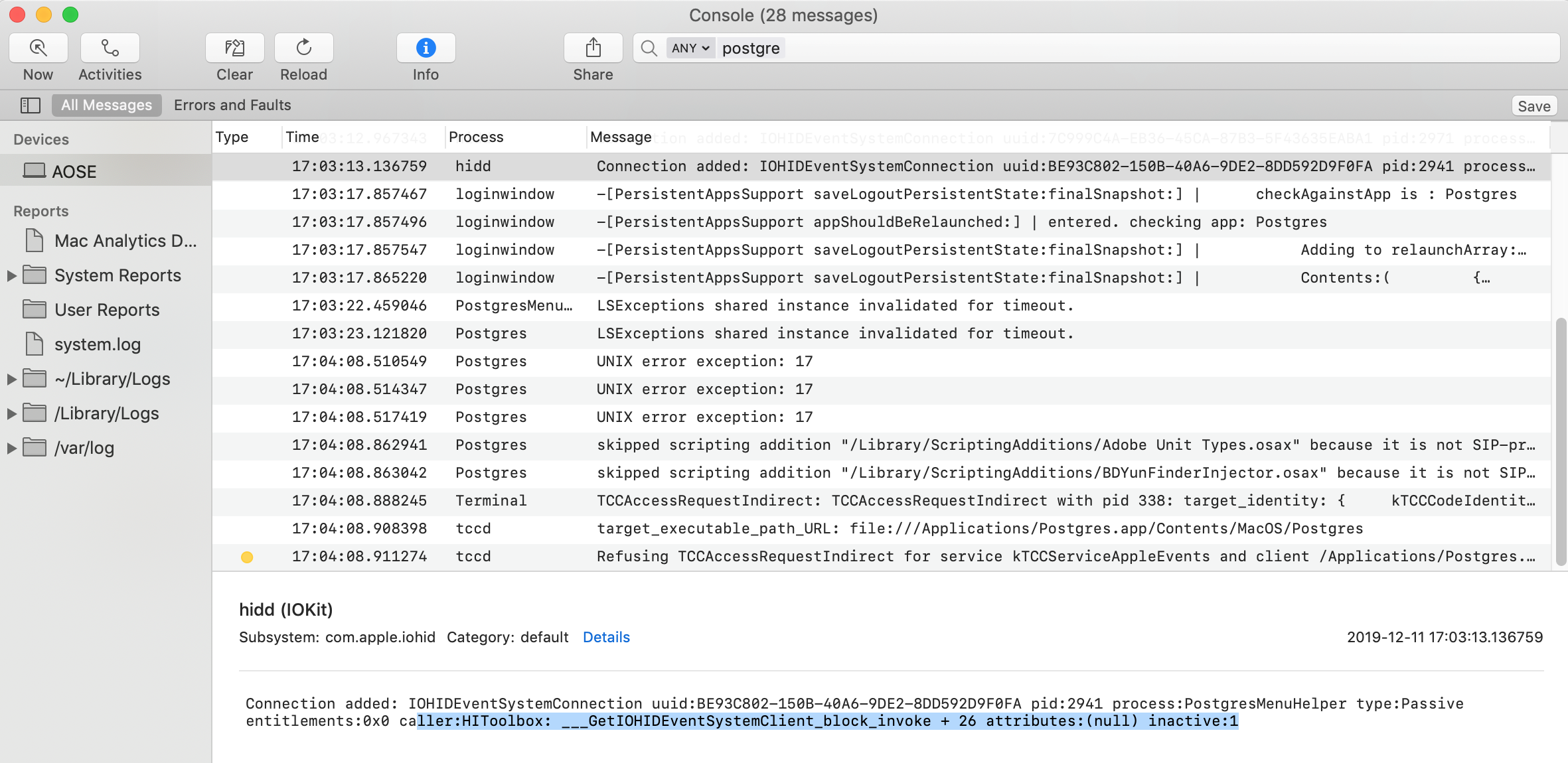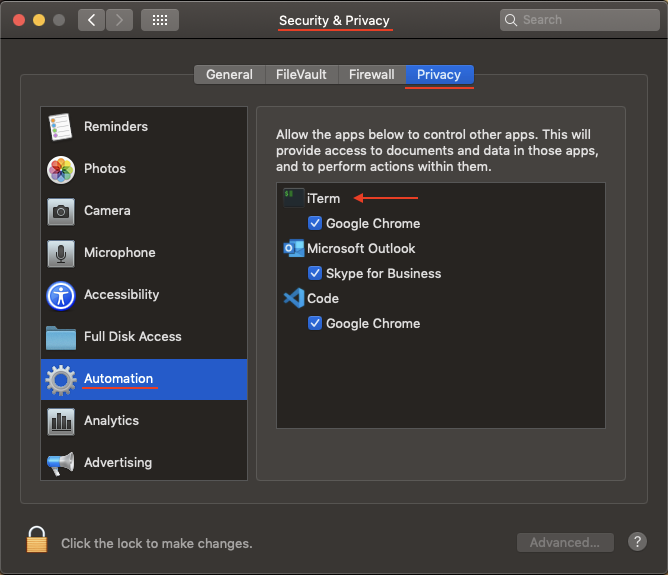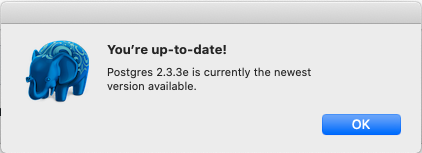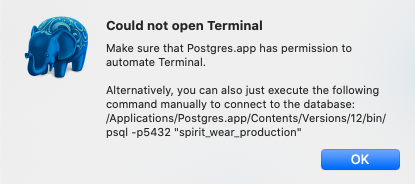New issue
Have a question about this project? Sign up for a free GitHub account to open an issue and contact its maintainers and the community.
By clicking “Sign up for GitHub”, you agree to our terms of service and privacy statement. We’ll occasionally send you account related emails.
Already on GitHub? Sign in to your account
Could not open Terminal #509
Comments
|
To connect to the database, you don't need to give Postgres.app permission to automate Terminal. You can just start psql from Terminal by yourself. If you've set up your $PATH correctly (see docs), and you haven't changed the port, you can just type If you do want to use the feature in Postgres.app where you double click on the database to connect, please open System preferences, go to "Security" -> "Privacy" -> "Automation" -> "Postgres" and enable automation of Terminal. |
|
That works, thanks Jakob. |
|
@jakob I have same trouble. Could not open Terminal when i double click the icon to connect database. And in "Security" -> "Privacy" -> "Automation" i don't find "Postgres" or other application. Here are my screen shot. |
|
Same as @vose2008 |
|
If you configured your $PATH correctly (as explained on the postgres.app homepage), and you use the default port, you can just type |
|
Yes, i can use |
|
Can you open Console.app, and then try to double click a database in Postgres.app? If the problem is a Sandbox issue, you would see an error message printed there. Alternatively, you can also try launching Postgres.app from the command line (instead of double clicking the app, launch the binary from the command line by typing |
|
Hey, jakob. It's work double click can connect the database by launch Postgres.app from Terminal. ------------WORK by Terminal------------- ------------Fuzz about console------------ |
|
The last line in the console looks similar to the error message reported here: Maybe we just need to set NSAppleEventsUsageDescription in Info.plist |
Otherwise macOS doesn't allow sending Apple Events (see issue #509). It should not be necessary for the helper app, but we add it just to be safe.
|
Thank you @jakob for showing us all the many alternative ways which we can access our postgresQL server. I believe the real issue though is that the |
|
@JMEssex Yes, I understand. I think it's because we're missing the key in the Info.plist. I'm currently working on an update to fix this. |
|
OK, the update is released. Can you try updating to the latest version (Postgres.app 2.3.3c) and see if it fixes the problem for you? |
|
@jakob Thank you! It works for me and my co-worker. |
|
Cool ! Now app work very well. Thank you ~~ XD |
|
@jakob Might there have been some regression here? I installed 2.3.3e today but I can no longer click the database and open it. Before this morning it was working fine, and I am able to run psql from the terminal and connect without issue, and I've enabled Postgres automation to terminal. |
|
@NerdtureUs Ugh, I thought I had finally fixed this issue...
|
|
@NerdtureUs Just to make sure it's not one of those random code signing failures, can you try restarting your Mac, and see if the issue persists? Is anything written to Console.app when you double click the database and the error is shown? (You need to open Console.app before triggering the warning to enable more detailed logging) |
|
@jakob Thanks for getting back so quickly. After the reboot, there was a system confirmation that showed up, to allow Postgres access to the terminal, which wasn't there previously. Once granted, I am able to click the database to launch and connect. |
|
Hi I can connect to Postgres by typing psql on the therminal. I am using the fish shell. however only the \q command works. nothing else (for eg. the \l command) seems to work . The error message is as follows - sh: more: command not found |
|
I can reproduce this bug when I try to use the Postgres app from a secondary user on my laptop. (The Automation is enabled so that's not the issue.) If I paste the provided command in the terminal everything works fine, but double-clicking on the database only works from the main user, where I installed the Postgres app. Hope this helps debugging. |
|
I had the same problem with Catalina on a MacBook Pro. I fiddled a lot, but Postgres wasn't added to the list of applications in system security. I tried this also with multiple user accounts. No luck. Finally it was solved with the following steps.
Now it works as expected |






I'm using Mojave 10.14.5. I first installed Postgres using Homebrew. Then instructions recommended removing the installation. I did that, then on first installation of Postgres.app, I didn't grant permission to my Terminal. I've tried uninstalling and reinstalling, and Resetting Postgres.app as described in the troubleshooting documentation. I don't know where to find the .profile file to edit the settings there. Regardless, I keep on receiving the message, "Make sure that Postgres.app has permission to automate Terminal."
The text was updated successfully, but these errors were encountered: